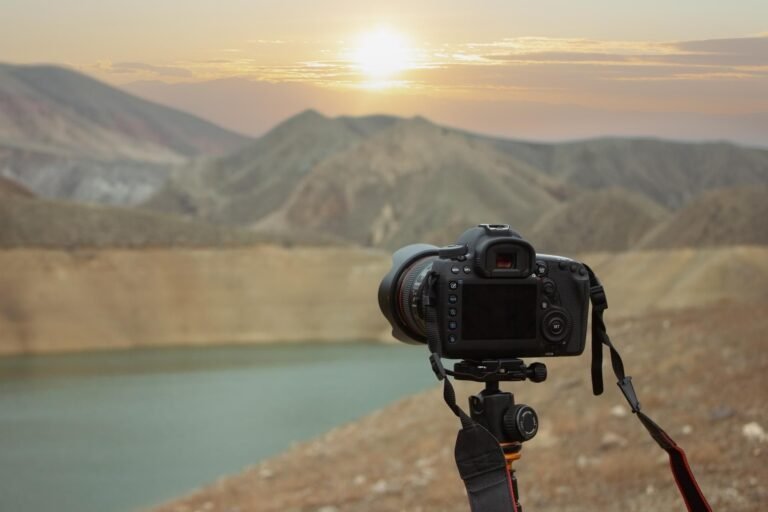Let’s chat about bracketing photography, shall we? This little-known gem is a technique for shooting the same scene at various exposure levels. Moving on, why all the fuss, you ask? Well, it’s not rocket science! Bracketing allows you to play it safe, providing a security blanket when lighting conditions are tricky. Moreover, it aids in creating high dynamic range (HDR) images that make your photos pop!
So, bracketing photography isn’t just some old relic. It’s a trusty tool, useful in the arsenal of any modern shutterbug. Mind you. It’s like riding a bike. A little practice, and you’ll sail smoothly!
Table of Contents
What Is Bracketing In Photography?
Well, snap! You’re about to dive into the exciting world of bracketing photography. What’s that, you ask? Bracketing in photography is the practice of capturing multiple shots of the same scene in different settings. It’s a bit like Goldilocks – you’re trying to find the shot that’s “just right.”
Now, let’s have a gander at why bracketing even exists. It is where understanding exposure enters the picture. It’s the heart and soul of bracketing, the bread to its butter. Exposure controls how much light hits your camera sensor. Too much, and your photo is overexposed. Too little, and it’s underexposed. So, to land on that sweet spot, you use bracketing to take several photos with varying exposures.
Here’s where it gets even more intriguing! There are three main types of bracketing to make your photos pop – exposure bracketing, focus bracketing, and white balance bracketing. As we just discussed, exposure bracketing involves messing with the amount of light. Moving on, focus bracketing adjusts the focus point in each shot, which is handy for close-ups. Lastly, white balance bracketing tweaks the colour temperature, making colours warmer or cooler. Three types and loads of possibilities.
Alright, brace yourself for the nitty-gritty. Bracketing isn’t just about the type; two key variables come into play: step size and number of frames. Step size dictates how much each setting changes between shots. A big step size equals big differences. The number of frames? It’s all about how many photos you’re taking in your bracket: more frames, more options. But remember, balance is key!
So there you have it! Bracketing photography in a nutshell. It’s a clever technique to ensure you get the perfect shot every time. And who knows, it might take your photography skills to new heights! So grab your camera, get out there, and start bracketing. The world is your oyster!
What Is Exposure Bracketing In Photography?
Lights, camera, action! We’re stepping into the realm of exposure bracketing photography, folks! In a nutshell, exposure bracketing is snapping numerous photos of the exact scene with various exposure levels. It’s like sampling ice cream flavours before settling on the perfect scoop!
So how does this magic work? It’s pretty straightforward. Your camera takes a series of shots at varying exposure levels – some underexposed (too dark), some overexposed (too bright), and some just right. It gives you an array of options, ensuring the best light balance.
But when’s the right time to use exposure bracketing? It is handy when dealing with tricky lighting situations – think sunset or sunrise, where shadows and bright light coexist. Also, bracketing becomes your secret weapon if you’re capturing high-contrast scenes.
But enough talk, let’s get down to brass tacks. Here’s how you can perform exposure bracketing. First, place your camera in aperture focus mode. Next, select your bracketing range and the number of frames. Lastly, fire away! It’s as easy as pie.

To give you a clearer picture, imagine you’re shooting a landscape at sunrise. The sky is bright, but the land is still dark. Normal exposure might bleach the sky or leave the land too dark. It is where exposure bracketing swoops in to save the day, giving you multiple shots to blend into the perfect image.
So there you have it, a quick dive into the world of exposure bracketing photography. It’s your golden ticket to ace those challenging shots. Now, go forth and bracket!
What Is Focus Bracketing In Photography?
Welcome, shutterbugs! Today, we’re zooming in on focus bracketing, another smart tool in bracketing photography. Essentially, focus bracketing involves capturing a series of shots with different focus points. It’s like spinning a radio dial until you tune into the perfect station!
So, how does it work? Well, you take several snaps of the same scene, shifting the focus point each time. Photographers commonly use this method to inject depth and sharpness into the entire image, especially when things are up close and personal.
The million-dollar question, of course, is when to use focus bracketing. The answer is simple: whenever you need more depth of field than your lens can offer. We’re talking about close-ups, macro photography, and landscapes with interesting foregrounds.
But how do you perform focus bracketing, you ask? It’s a walk in the park! You start by placing your camera to manual focus. Next, choose a starting focus point and take your first shot. Then,
subtly adjust your focus for each subsequent shot. The key is consistency; keep adjusting the focus by the same amount each time.
Imagine you’re capturing a beautiful flower up close with a stunning backdrop. The regular focus might blur either the flower or the background. But with focus bracketing, you can capture every petal and every leaf in crystal clear detail. You get multiple snaps to blend into one super-sharp, eye-popping image.
So, voila! That’s focus bracketing in a nutshell. This a handy trick for achieving that perfect sharpness across the board. So, why wait? Give focus bracketing a shot and watch your photography skills reach new heights!
What Is White Balance Bracketing In Photography?
Right off the bat, let’s get into bracketing photography, focusing on white balance bracketing. It’s a slick trick where your camera takes several photos at different white balance settings, giving you a wider range. Think of it as a buffet where you can pick the best serving of colour temperature! But how does it roll? Simple – you set the white balance bracketing on your camera, then press the shutter. Just like that, it churns out a bunch of shots with varying degrees of warm and cool tones.
Now, onto the question, ‘When’s the right time to use this nifty feature?’ Well, you know those tricky lighting situations that can make your photos look off? That’s your cue! Indoor lighting, sunsets, or oddly lit spaces are perfect instances to whip out white balance bracketing.
Moving on to the practical steps, don’t break a sweat. It’s a cinch! First, you need to dive into your camera’s settings. Search for ‘white balance bracketing’ and set the desired range. Once set, snap away! Your camera will do the heavy lifting, capturing multiple images with varied colour temperatures.
Finally, let’s talk about real-world scenarios where white balance bracketing is the bee’s knees. Have you ever tried to capture the perfect sunset, but the colours needed to be gentler? Or maybe that indoor wedding shoot with the lighting as unpredictable as the weather? Those are prime examples of where this technique can save the day. With a little practice, you’ll be nailing white balance bracketing like a pro!
The Role of Modern Cameras in Bracketing :
Diving straight into the world of bracketing photography, let’s tip our hats to modern cameras for their role in this fascinating process. These handy gadgets have evolved with automatic bracketing features, making the task as easy as pie. Once your settings are dialled in, the camera starts clicking away, giving you a range of exposures or white balance variations for that perfect shot.

As with anything under the sun, in-camera bracketing has its perks and quirks. On the upside, it’s a lifesaver in tricky lighting conditions, creating a safety net of shots to choose from. Plus, you can let your creative juices flow by blending exposures in post-production. But, on the flip side, you might hit a snag with moving subjects, where the slight differences in each frame could lead to a funky final image.
Another hiccup could be storage, as these bracketing operations can eat up your memory card faster than a kid with candy. Nonetheless, the rewards often outweigh the drawbacks, especially when you’re chasing that perfect shot!
Post-Processing in Bracketing Photography:
Let’s shine the spotlight on bracketing photography, especially the magic that happens post-click in the post-processing stage. For starters, we’ve got HDR, or High Dynamic Range imaging, a superstar in the world of bracketing. It takes your bracketed shots, each with a different exposure, and rolls them into one image that’s just right, capturing every little detail.
Of course, you’ll need the right tools to whip up this HDR masterpiece. Software like Lightroom, Photomatix, or Aurora HDR is the top dog in the bracketing post-processing game. With these, you can manually adjust the exposure of each image before blending them together.
When it comes to combining your images, it’s not just a matter of stacking them up. You’ve got to align them perfectly, making sure that no elements are out of place. Last but not least, here’s a nugget of advice for you: don’t go overboard with the HDR effect. It’s easy to get carried away, but subtlety is key. With a balanced hand and a keen eye, you’ll create bracketing masterpieces that pop!
Practical Tips and Tricks for Successful Bracketing in Photography:
Let’s cut to the chase and talk about the ins and outs of bracketing photography with some practical tips and tricks to make your shots shine. First off, picking the right scene for bracketing is crucial. You’re looking for a setting with a broad range of light and shadow where a single exposure might not cut the mustard.
Next up, let’s chat about our three-legged friend, the tripod. For bracketing, this guy is a must-have. It keeps your camera steady, ensuring your shots are aligned and ready for combining later.
Now, onto the boo-boos we need to dodge. One common pitfall is not capturing a wide enough range of exposures. Be bold to avoid this – crank up your bracketing settings! Another misstep is moving the camera between shots, but remember, that’s what your trusty tripod is for.
So there you have it, folks! With these tips tucked in your back pocket, you’re all set to delve deeper into the captivating world of bracketing photography. Happy shooting!

Conclusion:
Wrapping up our deep dive into bracketing photography, it’s clear as day that it’s a game-changer in modern photography. By giving photographers the tools to tackle tricky lighting and capture all the subtle details, it’s reshaping how we view the world through a lens. I reckon we’ll see more advancements in automatic bracketing and post-processing software, making this technique even more accessible.
But remember, the tech is only half the battle. You must pick the right scene, use a steady hand, and let your creativity run wild. With a little practice and these tips in mind, you’ll be mastering bracketing photography in no time!
Frequently Asked Questions:
A: Sure thing! Bracketing photography is where your camera snaps a series of photos, each with a different exposure or white balance. It gives you a buffet of shots to pick the best one from!
A: Bracketing shines in tricky lighting situations. Think sunsets, indoor shoots, or anywhere where a single exposure doesn’t cut it. When in doubt, bracket it out!
A: Now comes the fun part – post-processing! You can combine your shots into a single image that captures all the details using software like Lightroom or Photomatix.
A: Absolutely! Choosing the right scene is crucial; a tripod is your best friend. Remember to capture a wide range of exposures and keep your camera steady!
A: It’s a game-changer! Bracketing lets photographers capture details that would otherwise be lost. Plus, with improvements in automatic bracketing and post-processing software, it’s easier than ever to get that perfect shot.




